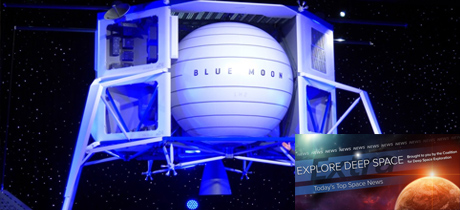In Today’s Deep Space Extra… Blue Origin presents its version of a commercial lunar lander that could join NASA’s efforts to return to the surface of the Moon with human explorers by 2024. Some experts are not ruling out some form of life on Mars. A plentiful sub Neptune class of extra solar planets may offer water worlds.
Human Space Exploration
Jeff Bezos unveils Blue Origin’s plan to land on the Moon
Axios (5/9): Amazon founder Jeff Bezos presented his Blue Moon concept for a lunar lander Thursday during a Washington ceremony. Built by Blue Origin, the commercial space company he founded to develop a family of suborbital and orbital launch vehicles, Blue Moon could be a commercial partner in NASA’s quest to return to the surface of the Moon with human explorers by 2024. The earliest version would transport cargo, an advanced version of the lander would transport humans to the lunar surface.
Why the Moon’s south pole may be the hottest destination in space
Coalition Member in the News – University of Mississippi
NatGeo.com (5/9): Blue Origin joins a fleet of space agencies and other private groups with their sights set on the lunar south pole. But why this region in particular, and what does the focus on the pole mean for potential human missions?
Opening up the Moon: Q&A with ‘Moon Rush’ author Leonard David
Space.com (5/9): Author Leonard David offers a supportive, candid discussion on why it’s time for human explorers to move on with a return to the lunar surface and prepare for destinations beyond.
Space Science
Could there be life on Mars today?
Space.com (5/9): Is Mars still habitable? Observations suggest the now dry desert like Red Planet was once warmer and that water flowed and ponded. A habitable atmosphere dissolved and a protective magnetic field disappeared. Some form of life, though, may lie below the surface.
Mysterious ‘sub-Neptunes’ are probably water worlds
Space.com (5/9): A Harvard led study of extra solar planets discovered with NASA’s Kepler space telescope suggests many of the worlds may be watery planets and between the Earth and Neptune in size. The study was published in the journal Proceedings of the National Academy of Sciences. Every sun like star may have at least one of the watery or icy sub Neptunes.
Planetary Society grants help astronomers track dangerous asteroids
Sky & Telescope (5/9): Amateur astronomers could become an important asset in humanity’s efforts to locate and track large asteroids that sweep close enough to the Earth in their trek around the sun to pose a potential impact threat. Their observations, as reported to the Minor Planet Center and updated, could become an important part of a planetary defense strategy “Suffice it to say, planetary defense is a team sport, and we couldn’t do it without the help of these semi-professional astronomers who labor in relative obscurity,” according to the report.
Other News
Shanahan’s nomination to be defense secretary gives continuity to space reorganization
SpaceNews.com (5/9): Former Boeing executive Pat Shanahan is President Trump’s choice for U.S. secretary of Defense. As the acting secretary, Shanahan has been an advocate for the President’s proposed Space Force, a new national security oriented arm of the military.

